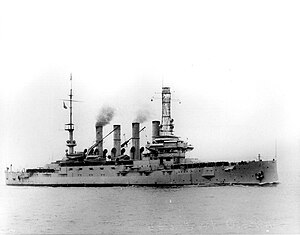 USS North Carolina (ACR-12), starboard bow view while underway, date and location unknown.
| |
| History | |
|---|---|
| Name | North Carolina |
| Namesake | State of North Carolina |
| Builder | Newport News Drydock & Shipbuilding Co., Newport News, Virginia |
| Laid down | 21 March 1905 |
| Launched | 6 October 1906 |
| Commissioned | 7 May 1908 |
| Decommissioned | 18 February 1921 |
| Renamed | Charlotte, 7 June 1920 |
| Stricken | 15 July 1930 |
| Fate | Sold for scrap, 29 September 1930 |
| General characteristics | |
| Class and type | Tennessee-class armored cruiser |
| Displacement | |
| Length | 504 ft 5 in (153.75 m) oa |
| Beam | 72 ft 10 in (22.20 m) |
| Draft | 25 ft (7.6 m) |
| Installed power |
|
| Propulsion | 2 × Triple expansion steam engines |
| Speed | 22 knots (41 km/h; 25 mph) |
| Complement | 914 |
| Armament |
|
| Armor |
|
USS North Carolina (ACR-12/CA-12) was a Tennessee-class armored cruiser of the United States Navy. The ship was built by Newport News Shipbuilding; she was laid down in March 1905, launched in October 1906, and was commissioned in May 1908. The final class of armored cruisers to be built for the US Navy, North Carolina and her sisters were armed with a main battery of four 10-inch (254 mm) guns, and were capable of a top speed of 22 knots (41 km/h; 25 mph).
North Carolina spent much of her career in the Atlantic Ocean and Caribbean Sea conducting training and visiting foreign countries. She went on short deployments to the Mediterranean Sea twice, the first in 1909 to protect American citizens in the Ottoman Empire, and the second during World War I, again to protect still neutral American citizens in the region. After the United States entered the war in April 1917, North Carolina was used to escort troop ships off the eastern coast of the United States. Following the war in late 1918 and early 1919, she was used to carry soldiers from the American Expeditionary Force back from France. In 1920, the ship was renamed Charlotte so her original name could be used for a new battleship, and she was decommissioned the following year. She was sold for scrap in September 1930 and broken up thereafter.